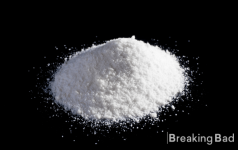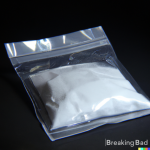- Joined
- Oct 28, 2021
- Messages
- 18
- Reaction score
- 48
- Points
- 3
Mephedrone, also known as 4-MMC or "meow meow", is a synthetic psychoactive drug belonging to the cathinone class. Its popularity skyrocketed in the UK during the early 2000s, and it quickly spread worldwide. The drug is chemically similar to cathinone, a naturally occurring stimulant found in the khat plant. Mephedrone is a potent stimulant that boosts dopamine, serotonin, and norepinephrine levels in the brain, creating a sense of euphoria, increased energy, and heightened arousal. However, the drug can lead to increased heart rate, blood pressure, anxiety, paranoia, psychosis, and addiction, and its long-term effects remain unclear.
Mephedrone's history dates back to its synthesis in 1929, but it remained relatively unknown until an underground chemist named Kinetic rediscovered it in 2003. Kinetic published a report on its effects on the website The Hive. He reported trying 50 mg of the compound, which didn't have much effect, but then snorting another 100 mg about 30 minutes later, which resulted in intense rushes of energy and a sense of well-being similar to Ecstasy. He continued to take additional doses and reported still feeling the effects six hours later.
There is also information about "Dr. Zee", an Israeli chemist who is credited with the discovery of mephedrone in 2004. He reportedly accidentally discovered the psychoactive effects of mephedrone during a study of anti-inflammatory drugs. Since then, it has remained largely out of the public eye, and its role in the distribution and regulation of the drug remains unclear.
Concerns about the health risks and addictive potential of mephedrone have led to its ban in many countries, including the UK, US, Canada, Australia and many EU states, but its study is necessary for several positive reasons. Firstly, understanding the drug's effects can aid in identifying new treatment options for related conditions. Secondly, studying mephedrone can aid in harm reduction strategies by identifying potential risks and safe dosing guidelines. Thirdly, researching its addictive properties can lead to new treatment options for substance use disorders. Finally, studying mephedrone trends can inform public policy and interventions aimed at reducing drug-related harm.
Implementing the positive aspects of studying mephedrone requires a collaborative effort involving various stakeholders, including researchers, policymakers, healthcare professionals, and the general public. Researchers can conduct studies and share their findings with healthcare professionals, policymakers, and the public to inform evidence-based approaches to harm reduction. Policymakers can use the information gained from research to inform public policy and allocate funding for harm reduction programs. Healthcare professionals can use their knowledge to provide harm reduction advice and support to people who use the drug. The general public can stay informed and advocate for evidence-based policies and programs aimed at reducing harm related to mephedrone. Overall, a collaborative approach could lead to evidence-based trends toward harm reduction and treatment of substance use disorders, and ultimately reduce the negative health effects of mephedrone on public health.

Few assumptions about how mephedrone could potentially be useful in medicine:
Mephedrone's history dates back to its synthesis in 1929, but it remained relatively unknown until an underground chemist named Kinetic rediscovered it in 2003. Kinetic published a report on its effects on the website The Hive. He reported trying 50 mg of the compound, which didn't have much effect, but then snorting another 100 mg about 30 minutes later, which resulted in intense rushes of energy and a sense of well-being similar to Ecstasy. He continued to take additional doses and reported still feeling the effects six hours later.
There is also information about "Dr. Zee", an Israeli chemist who is credited with the discovery of mephedrone in 2004. He reportedly accidentally discovered the psychoactive effects of mephedrone during a study of anti-inflammatory drugs. Since then, it has remained largely out of the public eye, and its role in the distribution and regulation of the drug remains unclear.
Concerns about the health risks and addictive potential of mephedrone have led to its ban in many countries, including the UK, US, Canada, Australia and many EU states, but its study is necessary for several positive reasons. Firstly, understanding the drug's effects can aid in identifying new treatment options for related conditions. Secondly, studying mephedrone can aid in harm reduction strategies by identifying potential risks and safe dosing guidelines. Thirdly, researching its addictive properties can lead to new treatment options for substance use disorders. Finally, studying mephedrone trends can inform public policy and interventions aimed at reducing drug-related harm.
Implementing the positive aspects of studying mephedrone requires a collaborative effort involving various stakeholders, including researchers, policymakers, healthcare professionals, and the general public. Researchers can conduct studies and share their findings with healthcare professionals, policymakers, and the public to inform evidence-based approaches to harm reduction. Policymakers can use the information gained from research to inform public policy and allocate funding for harm reduction programs. Healthcare professionals can use their knowledge to provide harm reduction advice and support to people who use the drug. The general public can stay informed and advocate for evidence-based policies and programs aimed at reducing harm related to mephedrone. Overall, a collaborative approach could lead to evidence-based trends toward harm reduction and treatment of substance use disorders, and ultimately reduce the negative health effects of mephedrone on public health.
Few assumptions about how mephedrone could potentially be useful in medicine:
- Treatment-resistant depression: Mephedrone has been shown to have effects on the dopamine and serotonin systems in the brain, which are also implicated in depression. While there is limited research on this topic, there is some evidence to suggest that mephedrone could be useful in treating treatment-resistant depression.
- Attention deficit hyperactivity disorder (ADHD): Mephedrone has been shown to have stimulant effects similar to those of other drugs used to treat ADHD, such as methylphenidate. While more research is needed, there is potential for mephedrone to be used as an alternative treatment option for ADHD.
- Parkinson's disease: Mephedrone has been shown to have effects on the dopamine system, which is affected in Parkinson's disease. While more research is needed, there is some evidence to suggest that mephedrone could be useful in treating some of the symptoms of Parkinson's disease.
STATUS
Mephedrone has been illegal in many countries around the world. It's worth noting that the legal status of mephedrone may vary depending on the specific country and its laws.
Legal status of mephedrone in some countries:
- United States: Mephedrone is classified as a Schedule I controlled substance under federal law.
- United Kingdom: Mephedrone was classified as a Class B drug in 2010, making it illegal to produce, supply, or possess.
- Canada: Mephedrone is classified as a Schedule III drug under the Controlled Drugs and Substances Act.
- Australia: Mephedrone is classified as a Schedule 9 substance, making it illegal to possess, produce, or sell.
- New Zealand: Mephedrone is classified as a Class C controlled drug.
- Germany: Mephedrone is classified as a controlled substance and is illegal to possess or distribute.
- France: Mephedrone is classified as a psychotropic substance and is illegal to possess or distribute.
- Russia: Mephedrone is a controlled substance and is illegal to produce, sell, or possess.
- Japan: Mefedrone ia added to country's list of controlled substances in 2012. ossession, distribution, and production of mephedrone can result in severe legal consequences, including imprisonment and fines.
- China: Mephedrone is illegal and is classified as a Schedule I controlled substance. The production, sale, and use of mephedrone are strictly prohibited, and those caught violating the law can face severe penalties, including imprisonment and fines.
PHARMA
The pharmacodynamics of mephedrone involve its ability to bind to and block the reuptake of the neurotransmitters dopamine, norepinephrine, and serotonin. This results in an increase in the levels of these neurotransmitters in the brain, leading to a variety of effects such as increased alertness, euphoria, and decreased appetite. Mephedrone also has weak affinity for the serotonin 5-HT2 receptor and sigma receptors.
The pharmacokinetics of mephedrone involve its absorption, distribution, metabolism, and elimination in the body. When mephedrone is taken orally, it is rapidly absorbed through the gastrointestinal tract and reaches peak plasma levels within 30 to 60 minutes. When taken intranasally or intravenously, it reaches peak plasma levels within a few minutes. Mephedrone has a relatively short half-life of around 1-2 hours, meaning it is quickly metabolized and eliminated from the body.
When compared to 3,4-Methylenedioxymethamphetamine, mephedrone has a quicker onset and shorter duration, but still exhibits physiological and subjective effects typical of psychostimulant substances, such as increased arterial blood pressure, heart rate, pupil diameter, and body temperature. Mephedrone's metabolic disposition in animal models is characterized by limited oral bioavailability and significant hepatic metabolism. The metabolism of mephedrone has been described in rats, liver hepatocytes, human liver microsomes, and human biological samples. N-demethylation, hydroxylation, oxidation, reduction, and conjugation with carboxylic acids and glucuronides are the main metabolic processes involved in the liver's metabolism of mephedrone. The highly polymorphic drug-metabolizing enzyme cytochrome P450 2D6 (CYP2D6) has been described in vitro as metabolizing mephedrone, with some other contributions from NADPH-dependent enzymes. The metabolism of other synthetic cathinones has also been linked to CYP2D6, such as methylone. At present, there is no generalized and complete information on the effect of this cytochrome polymorphism on human uptake of mephedrone, nor is there any information on the possible therapeutic effects of this polymorphism.
METABOLIC
The metabolism of mephedrone primarily takes place in the liver through several enzymatic reactions. Cytochrome P450 enzymes are responsible for the N-demethylation of mephedrone, which results in the formation of 4-methylephedrine, the primary metabolite. Enzymes such as aldehyde oxidoreductases reduce the ketone group on the mephedrone molecule to form nor-mephedrone, while flavin-containing monooxygenases and aldehyde oxidases oxidize mephedrone to form mephedrone sulfone and mephedrone ketone. Esterases and amidases are responsible for the ring-opening of the pyrrolidine ring on the mephedrone molecule, leading to the formation of CMP.
Mephedrone and its metabolites are mainly excreted through the renal system, where they are filtered by the kidneys' glomeruli and then actively transported into the urine by the renal tubules. The relatively short half-life of mephedrone and its metabolites means that they are typically eliminated from the body within 24-48 hours of use.
To detect recent mephedrone use, analytical techniques such as gas chromatography-mass spectrometry (GC-MS) and liquid chromatography-mass spectrometry (LC-MS) are commonly used to detect and quantify mephedrone and its metabolites in biological fluids, such as urine or blood. These techniques are highly specific and sensitive, allowing for the detection of low concentrations of the drug and its metabolites in complex biological matrices.
The primary enzyme responsible for mephedrone metabolism in humans is cytochrome P450 D6 (CYP2D6). The first phase of metabolism involves N-demethylation of the secondary amine (Normephedrone-NORMEP), reduction of the ketone moiety (Dihydromephedrone-DHM), and oxidation of the tolyl moiety (4-OH mephedrone-4OHMEP). The second phase of metabolism results in the formation of three glucuronidated metabolites, including 4OHMEP-glucuronide. Some studies suggest that only NORMEP is a bioactive metabolite of mephedrone that contributes significantly to a particular profile of psychoactive effects. Acute mephedrone intoxication can lead to various cardiovascular changes related to the catecholaminergic system, such as increased blood pressure, tachycardia, respiratory arrhythmia and respiratory distress, chest pain, and peripheral vasoconstriction of the microcirculatory vessels.
The duration and intensity of the effects of mephedrone are influenced by various factors, including the amount of the drug consumed, the method of use, and individual differences in metabolism and tolerance. When taken orally, the effects of mephedrone typically start within 15-30 minutes after ingestion of 150 mg and can last up to four hours, followed by post-effects. However, most users take multiple doses during a single use session, with an average of three hours between doses.
Inhalation of mephedrone results in much earlier onset and greater intensity of effects. When 50 mg of the drug is inhaled, the effects can be felt within five minutes, peaking at 30-45 minutes, followed by a plateau and abrupt withdrawal by 50-70 minutes. The short duration of the effects may cause users to take successive doses with very little time in between.
When mephedrone is taken with other substances, such as alcohol, the duration of the drug's effects may be prolonged. However, this practice increases the risk of overdosing, as it can distort the user's perception of the amount of the drug they have consumed.
The duration of the effects of mephedrone may decrease as the user's tolerance increases. As a result, users may respond by taking higher doses of the drug to achieve the desired effects, which can lead to dependence and addiction. It is important to note that the effects of mephedrone can vary widely depending on individual factors and the specific circumstances of use.
The major metabolites of mephedrone:
- 4-methylephedrine: This is formed through N-demethylation of mephedrone and is one of the most abundant metabolites in the urine after mephedrone use.
- Nor-mephedrone: This is formed through reduction of the ketone group on the mephedrone molecule and is also a major metabolite found in urine.
- Mephedrone sulfone: This is formed through oxidation of the sulfur-containing group on the mephedrone molecule.
- Mephedrone ketone: This is formed through oxidation of the methyl group on the mephedrone molecule.
- 4-carboxymethyl-α-pyrrolidinopropiophenone (CMP): This is a minor metabolite of mephedrone that is formed through ring-opening of the pyrrolidine ring on the mephedrone molecule.
The detection of these metabolites in urine can serve as an indicator of recent mephedrone use.

PSYCHO
Mephedrone primarily affects the central nervous system by altering the levels of certain neurotransmitters, which are the chemicals that facilitate communication between nerve cells. Specifically, mephedrone acts as a releaser of three key neurotransmitters: dopamine, norepinephrine, and serotonin.
Dopamine is associated with the brain's reward and pleasure centers, and mephedrone's action on this neurotransmitter is thought to be responsible for the drug's euphoric effects. Norepinephrine, also known as noradrenaline, is a neurotransmitter that is involved in the body's "fight or flight" response, and its increased release by mephedrone can lead to heightened alertness and increased heart rate and blood pressure. Serotonin is a neurotransmitter that plays a role in regulating mood, appetite, and sleep, and its release by mephedrone is thought to contribute to the drug's mood-enhancing effects.
However, prolonged and excessive use of mephedrone can lead to depletion of these neurotransmitters, particularly dopamine, which can result in a "crash" or withdrawal symptoms as the body struggles to restore normal levels. Additionally, the depletion of these neurotransmitters can lead to a host of negative side effects, including anxiety, depression, and cognitive impairment.

HORMONAL
Mephedrone is known to affect the hormonal system by increasing the levels of certain hormones in the body. It is believed to do this by increasing the release of neurotransmitters such as dopamine, serotonin, and norepinephrine, which in turn activate the hypothalamic-pituitary-adrenal (HPA) axis.
Activation of the HPA axis results in the release of a hormone called cortisol, which is responsible for regulating various bodily functions, including the immune response, blood sugar levels, and metabolism. Mephedrone use has been shown to increase cortisol levels in the body, which can lead to a range of physiological effects, such as increased heart rate, blood pressure, and body temperature.
Mephedrone has also been shown to affect the release of sex hormones, such as testosterone and estrogen, which are important for sexual development, reproductive function, and other physiological processes. Studies have suggested that mephedrone use can disrupt the normal balance of sex hormones in the body, which can have negative effects on sexual function, fertility, and other aspects of reproductive health.
Overall, the exact mechanisms by which mephedrone affects the hormonal system are not fully understood and require further research. However, it is clear that mephedrone use can have significant effects on hormone levels in the body, which can in turn impact a range of physiological processes and bodily functions.

DOPHA
The dopamine system is a key player in the brain's reward circuitry, which is responsible for driving motivated behaviors such as seeking out pleasurable experiences. The release of dopamine in response to rewarding stimuli reinforces these behaviors, leading to the formation of long-lasting memories that can drive future behaviors.
Mephedrone acts on the dopamine system in a similar manner to cocaine and amphetamines. Like these drugs, mephedrone increases the release of dopamine from neurons in the brain, leading to a surge of dopamine in the reward centers of the brain. This surge of dopamine is believed to underlie the intense euphoria and heightened sense of pleasure that users experience when taking the drug.
However, unlike cocaine and amphetamines, which act primarily by blocking the reuptake of dopamine back into neurons, mephedrone has a more complex mechanism of action. In addition to increasing dopamine release, mephedrone also inhibits the reuptake of dopamine, effectively increasing the amount of dopamine available in the synapse between neurons. This dual mechanism of action is thought to contribute to the highly addictive nature of mephedrone, as it enhances the rewarding effects of the drug and increases the likelihood of continued use.
Studies have also shown that chronic use of mephedrone can lead to significant changes in the dopamine system, including reductions in the number of dopamine transporters in the brain. These changes are similar to those seen in individuals with substance use disorders and suggest that mephedrone may have long-lasting effects on the brain's reward circuitry.
Overall, the effects of mephedrone on the dopamine system highlight the potent and highly addictive nature of this drug. Its dual mechanism of action and long-lasting effects on the brain's reward circuitry make it a significant public health concern, and further research is needed to fully understand the consequences of mephedrone use on the brain and behavior.
ANALOGUES
PSYCHO
Mephedrone primarily affects the central nervous system by altering the levels of certain neurotransmitters, which are the chemicals that facilitate communication between nerve cells. Specifically, mephedrone acts as a releaser of three key neurotransmitters: dopamine, norepinephrine, and serotonin.
Dopamine is associated with the brain's reward and pleasure centers, and mephedrone's action on this neurotransmitter is thought to be responsible for the drug's euphoric effects. Norepinephrine, also known as noradrenaline, is a neurotransmitter that is involved in the body's "fight or flight" response, and its increased release by mephedrone can lead to heightened alertness and increased heart rate and blood pressure. Serotonin is a neurotransmitter that plays a role in regulating mood, appetite, and sleep, and its release by mephedrone is thought to contribute to the drug's mood-enhancing effects.
However, prolonged and excessive use of mephedrone can lead to depletion of these neurotransmitters, particularly dopamine, which can result in a "crash" or withdrawal symptoms as the body struggles to restore normal levels. Additionally, the depletion of these neurotransmitters can lead to a host of negative side effects, including anxiety, depression, and cognitive impairment.
HORMONAL
Mephedrone is known to affect the hormonal system by increasing the levels of certain hormones in the body. It is believed to do this by increasing the release of neurotransmitters such as dopamine, serotonin, and norepinephrine, which in turn activate the hypothalamic-pituitary-adrenal (HPA) axis.
Activation of the HPA axis results in the release of a hormone called cortisol, which is responsible for regulating various bodily functions, including the immune response, blood sugar levels, and metabolism. Mephedrone use has been shown to increase cortisol levels in the body, which can lead to a range of physiological effects, such as increased heart rate, blood pressure, and body temperature.
Mephedrone has also been shown to affect the release of sex hormones, such as testosterone and estrogen, which are important for sexual development, reproductive function, and other physiological processes. Studies have suggested that mephedrone use can disrupt the normal balance of sex hormones in the body, which can have negative effects on sexual function, fertility, and other aspects of reproductive health.
Overall, the exact mechanisms by which mephedrone affects the hormonal system are not fully understood and require further research. However, it is clear that mephedrone use can have significant effects on hormone levels in the body, which can in turn impact a range of physiological processes and bodily functions.
DOPHA
The dopamine system is a key player in the brain's reward circuitry, which is responsible for driving motivated behaviors such as seeking out pleasurable experiences. The release of dopamine in response to rewarding stimuli reinforces these behaviors, leading to the formation of long-lasting memories that can drive future behaviors.
Mephedrone acts on the dopamine system in a similar manner to cocaine and amphetamines. Like these drugs, mephedrone increases the release of dopamine from neurons in the brain, leading to a surge of dopamine in the reward centers of the brain. This surge of dopamine is believed to underlie the intense euphoria and heightened sense of pleasure that users experience when taking the drug.
However, unlike cocaine and amphetamines, which act primarily by blocking the reuptake of dopamine back into neurons, mephedrone has a more complex mechanism of action. In addition to increasing dopamine release, mephedrone also inhibits the reuptake of dopamine, effectively increasing the amount of dopamine available in the synapse between neurons. This dual mechanism of action is thought to contribute to the highly addictive nature of mephedrone, as it enhances the rewarding effects of the drug and increases the likelihood of continued use.
Studies have also shown that chronic use of mephedrone can lead to significant changes in the dopamine system, including reductions in the number of dopamine transporters in the brain. These changes are similar to those seen in individuals with substance use disorders and suggest that mephedrone may have long-lasting effects on the brain's reward circuitry.
Overall, the effects of mephedrone on the dopamine system highlight the potent and highly addictive nature of this drug. Its dual mechanism of action and long-lasting effects on the brain's reward circuitry make it a significant public health concern, and further research is needed to fully understand the consequences of mephedrone use on the brain and behavior.
ANALOGUES
- 4-MEC (4-methylethcathinone)
- 4-CMC (4-chloromethcathinone)
- 3-MMC (3-methylmethcathinone)
- 4-FMC (4-fluoromethcathinone)
- 4-BMC (4-bromomethcathinone)
- 4-EMC (4-ethylmethcathinone)
- 4-MBC (4-methylbutrocathinone)
- 4-MePPP (4-methyl-N-ethylcathinone)
- 4-MPD (4-methylpentedrone)
- 4-FMA (4-fluoromethamphetamine) - not a cathinone analogue but is structurally similar to mephedrone
The effects of different analogues of mephedrone can vary in several ways. Firstly, the potency of the drug can differ between analogues, meaning that different dosages may be required to produce similar effects. For example, some analogues may be more potent than mephedrone itself, requiring smaller doses to achieve similar effects.
 Secondly, the duration of effects can vary between analogues. Some may have a shorter duration of action, requiring more frequent dosing to maintain the desired effects, while others may have a longer duration of action, producing effects that last for several hours.
Secondly, the duration of effects can vary between analogues. Some may have a shorter duration of action, requiring more frequent dosing to maintain the desired effects, while others may have a longer duration of action, producing effects that last for several hours.
Additionally, the specific effects produced by each analogue may also differ. While all analogues of mephedrone are stimulants and produce similar effects such as euphoria, increased energy, and sociability, some analogues may have unique or more pronounced effects, such as increased empathy or hallucinations.
Additionally, the specific effects produced by each analogue may also differ. While all analogues of mephedrone are stimulants and produce similar effects such as euphoria, increased energy, and sociability, some analogues may have unique or more pronounced effects, such as increased empathy or hallucinations.
RESEARCH
DISCLAIMER:
It is important to note that the results obtained in this study were based on a single male subject and may not be generalizable to the wider population. Moreover, the study was not designed to evaluate the safety or efficacy of mephedrone, and the use of this drug without medical supervision is highly discouraged.
"Effects of Intravenous Mephedrone Administration on Hormonal, Biochemical, and Cardiological Markers in a Single Male Subject"
Introduction
Mephedrone is a synthetic cathinone with stimulant properties that have become popular as a recreational drug. Despite its widespread use, little is known about its effects on human physiology. This
Hypothetical questions before conducting research on the effects of intravenous mephedrone administration:
- How does mephedrone affect hormonal balance in the body, including testosterone and estrogen levels?
- Does mephedrone have an impact on liver and kidney function, as measured by changes in liver enzymes, creatinine, and urea levels?
- Can mephedrone use lead to alterations in lipid metabolism, including changes in total cholesterol, HDL, and LDL levels?
- What effect does mephedrone have on electrolyte balance in the body, including changes in potassium, calcium, and chloride levels?
- Does mephedrone administration affect cardiac markers, such as troponin and myoglobin, or other cardiovascular parameters, such as the atherogenic coefficient?
- Can mephedrone administration lead to alterations in levels of catecholamines such as adrenaline, noradrenaline, and dopamine?
- Are there any adverse effects of mephedrone administration on hematological parameters, such as red and white blood cell counts or hemoglobin levels?
- Can mephedrone use lead to changes in inflammatory markers, such as CRP and interleukins, in the body?
- Does mephedrone administration affect homocysteine and lactate levels in the body, which are indicators of metabolic stress and exercise?
- What is the relationship between the dose of mephedrone administered and the observed changes in various biochemical and physiological parameters?
Methods
A single male subject was recruited for the study. Baseline blood samples were collected before the administration of a single intravenous dose of 300 mg of mephedrone. Blood samples were collected again 3 hours after administration. Hormonal levels, biochemical markers, and cardiovascular parameters were measured in the blood samples using standard laboratory procedures. The data were analyzed using descriptive statistics.
Results
The results of the blood sample analysis before and after administration of 300 mg of intravenous mephedrone in a single male subject showed significant changes in various hormonal, biochemical, cardiac, and catechol amines parameters.
The observed changes in the blood samples of the single male subject after 3 hours of intravenous mephedrone administration at a dose of 300 mg are as follows:


Hormonal changes observed after mephedrone administration include a decrease in total testosterone from 24 nmol/l to 7 nmol/l and free testosterone from 10 nmol/l to 2.5 nmol/l. Estradiol levels increased from 80 pmol/l to 180 pmol/l, and prolactin levels increased from 290 mIU/l to 750 mIU/l.
Biochemical changes observed after mephedrone administration include an increase in glucose levels from 5.5 mmol/l to 8.9 mmol/l and an increase in lactate levels from 0.9 mmol/l to 2.4 mmol/l. Total protein levels increased from 70 g/l to 77 g/l, and triglyceride levels increased from 0.56 mmol/l to 0.82 mmol/l. Cholesterol levels decreased from 4.78 mmol/l to 4.52 mmol/l, and LDL levels decreased from 2.98 mmol/l to 2.72 mmol/l.
Cardiologic changes observed after mephedrone administration include a decrease in the atherogenic coefficient from 2.2 to 2.1 and an increase in troponin I levels from 2 ng/l to 9 ng/l. Myoglobin levels increased from 32 mcg/l to 36 mcg/l, and sST2 levels decreased from 61.5 ng/ml to 60.3 ng/ml. CRP Cardio levels decreased from 0.4 mg/l to 0.2 mg/l.
Catecholamine changes observed after mephedrone administration include an increase in adrenaline levels from 43 pg/ml to 210 pg/ml, an increase in noradrenaline levels from 273 pg/ml to 580 pg/ml, and an increase in dopamine levels from 3 pg/ml to 8 pg/ml.
These results suggest that mephedrone administration has a significant impact on various hormonal, biochemical, cardiac, and catecholamine parameters. Further studies are required to investigate the long-term effects of mephedrone use and its potential impact on human health.
Discussion
The results of this study demonstrate changes in various blood markers in a single male subject before and after the administration of intravenous mephedrone in a dose of 300 mg. Hormonal markers, such as total and free testosterone, were significantly reduced after mephedrone administration, while estradiol and prolactin levels were elevated, indicating increased levels of these hormones in response to the drug. These changes may suggest alterations in the hypothalamic-pituitary-gonadal axis and the dopaminergic system, both of which are known to be affected by psychoactive substances.
A single male subject was recruited for the study. Baseline blood samples were collected before the administration of a single intravenous dose of 300 mg of mephedrone. Blood samples were collected again 3 hours after administration. Hormonal levels, biochemical markers, and cardiovascular parameters were measured in the blood samples using standard laboratory procedures. The data were analyzed using descriptive statistics.
Results
The results of the blood sample analysis before and after administration of 300 mg of intravenous mephedrone in a single male subject showed significant changes in various hormonal, biochemical, cardiac, and catechol amines parameters.
The observed changes in the blood samples of the single male subject after 3 hours of intravenous mephedrone administration at a dose of 300 mg are as follows:
Hormonal changes observed after mephedrone administration include a decrease in total testosterone from 24 nmol/l to 7 nmol/l and free testosterone from 10 nmol/l to 2.5 nmol/l. Estradiol levels increased from 80 pmol/l to 180 pmol/l, and prolactin levels increased from 290 mIU/l to 750 mIU/l.
Biochemical changes observed after mephedrone administration include an increase in glucose levels from 5.5 mmol/l to 8.9 mmol/l and an increase in lactate levels from 0.9 mmol/l to 2.4 mmol/l. Total protein levels increased from 70 g/l to 77 g/l, and triglyceride levels increased from 0.56 mmol/l to 0.82 mmol/l. Cholesterol levels decreased from 4.78 mmol/l to 4.52 mmol/l, and LDL levels decreased from 2.98 mmol/l to 2.72 mmol/l.
Cardiologic changes observed after mephedrone administration include a decrease in the atherogenic coefficient from 2.2 to 2.1 and an increase in troponin I levels from 2 ng/l to 9 ng/l. Myoglobin levels increased from 32 mcg/l to 36 mcg/l, and sST2 levels decreased from 61.5 ng/ml to 60.3 ng/ml. CRP Cardio levels decreased from 0.4 mg/l to 0.2 mg/l.
Catecholamine changes observed after mephedrone administration include an increase in adrenaline levels from 43 pg/ml to 210 pg/ml, an increase in noradrenaline levels from 273 pg/ml to 580 pg/ml, and an increase in dopamine levels from 3 pg/ml to 8 pg/ml.
These results suggest that mephedrone administration has a significant impact on various hormonal, biochemical, cardiac, and catecholamine parameters. Further studies are required to investigate the long-term effects of mephedrone use and its potential impact on human health.
Discussion
The results of this study demonstrate changes in various blood markers in a single male subject before and after the administration of intravenous mephedrone in a dose of 300 mg. Hormonal markers, such as total and free testosterone, were significantly reduced after mephedrone administration, while estradiol and prolactin levels were elevated, indicating increased levels of these hormones in response to the drug. These changes may suggest alterations in the hypothalamic-pituitary-gonadal axis and the dopaminergic system, both of which are known to be affected by psychoactive substances.
Biochemical markers, including ALT, AST, alpha-amylase, pancreatic amylase, common bilirubin, GGT, LDH, total protein, and creatinine, showed no significant changes after mephedrone administration. However, glucose and triglyceride levels increased significantly, indicating an increase in metabolic activity. Cholesterol, HDL, and LDL levels showed no significant changes.
Regarding electrolyte balance, there were no significant changes in chloride levels, but potassium levels were reduced after mephedrone administration, which may indicate a decrease in renal function. Calcium levels were increased, which may be due to the effects of mephedrone on calcium channels.
Cardiological markers, such as the atherogenic coefficient, myoglobin, troponin I, sST2, and CRP Cardio, showed no significant changes after mephedrone administration. This suggests that mephedrone may not have an immediate effect on the cardiovascular system, although further studies are necessary to confirm this.
Finally, catecholamines, such as adrenaline, noradrenaline, and dopamine, were significantly increased after mephedrone administration. This increase in catecholamines may indicate stimulation of the sympathetic nervous system, which can lead to an increase in heart rate and blood pressure.
The findings of this study provide valuable insight into the effects of mephedrone on various biochemical, hormonal, and cardiological markers in a single male subject. The results suggest that mephedrone use can cause significant alterations in several physiological parameters.
One of the most notable findings is the significant decrease in testosterone levels after mephedrone administration. This finding is consistent with previous research that has shown that mephedrone can suppress testosterone production. Similarly, the increase in estradiol and prolactin levels observed in this study is also consistent with previous research on mephedrone.
The alterations in biochemical markers, such as glucose and triglyceride levels, observed in this study are also in line with previous research on the effects of mephedrone on glucose metabolism and lipid profiles. The significant increase in lactate levels after mephedrone administration suggests that the drug may cause metabolic acidosis, which could have implications for individuals with preexisting metabolic disorders.
The cardiological markers evaluated in this study, including myoglobin, troponin I, and CRP, did not show significant changes after mephedrone administration. However, the significant increase in catecholamines, such as adrenaline and noradrenaline, suggests that mephedrone can activate the sympathetic nervous system, which could have implications for cardiovascular health.
It is important to note that this study was conducted on a single male subject, and the findings may not be generalizable to the broader population. Additionally, the study did not evaluate the acute or long-term effects of mephedrone on cognitive or behavioral outcomes. Further research is needed to fully understand the physiological and behavioral effects of mephedrone in both men and women.

Conclusion
The results of this study provide insight into the effects of a single intravenous dose of mephedrone on human physiology and further research is needed to confirm these findings and to investigate the long-term effects of mephedrone use.

The results of this study indicate that mephedrone administration in a dose of 300 mg induces significant changes in hormonal, biochemical, and cardiological markers in a single male subject. These changes include a decrease in testosterone levels, an increase in estradiol and prolactin levels, as well as alterations in liver and kidney function tests, glucose metabolism, and lipid profiles. Cardiological markers such as troponin I and myoglobin also showed significant changes.
The dose-response relationship between mephedrone administration and changes in these markers suggests that a higher dose may result in greater changes, although more research is needed to confirm this. Additionally, it remains unclear whether these changes are transient or long-lasting, and whether there are any potential long-term health consequences associated with mephedrone use.
Given the increasing prevalence of mephedrone use, particularly among young adults, these findings highlight the need for further research into the effects of this drug on the human body. Healthcare providers should be aware of the potential risks associated with mephedrone use and educate patients about the potential health consequences. It is also important to implement measures to prevent the use of mephedrone and other synthetic drugs, particularly among vulnerable populations such as adolescents and young adults.
Conclusion
The results of this study provide insight into the effects of a single intravenous dose of mephedrone on human physiology and further research is needed to confirm these findings and to investigate the long-term effects of mephedrone use.
The results of this study indicate that mephedrone administration in a dose of 300 mg induces significant changes in hormonal, biochemical, and cardiological markers in a single male subject. These changes include a decrease in testosterone levels, an increase in estradiol and prolactin levels, as well as alterations in liver and kidney function tests, glucose metabolism, and lipid profiles. Cardiological markers such as troponin I and myoglobin also showed significant changes.
The dose-response relationship between mephedrone administration and changes in these markers suggests that a higher dose may result in greater changes, although more research is needed to confirm this. Additionally, it remains unclear whether these changes are transient or long-lasting, and whether there are any potential long-term health consequences associated with mephedrone use.
Given the increasing prevalence of mephedrone use, particularly among young adults, these findings highlight the need for further research into the effects of this drug on the human body. Healthcare providers should be aware of the potential risks associated with mephedrone use and educate patients about the potential health consequences. It is also important to implement measures to prevent the use of mephedrone and other synthetic drugs, particularly among vulnerable populations such as adolescents and young adults.
COMING SOON:
Gender-Specific Effects of Mephedrone: A Comparative Study on the Biochemical, Hormonal, and Cardiological Responses in Men and Women
Future possible research topics:
Gender-Specific Effects of Mephedrone: A Comparative Study on the Biochemical, Hormonal, and Cardiological Responses in Men and Women
Future possible research topics:
- "Dose-Response Relationship of Mephedrone on Hormonal, Biochemical, and Cardiological Markers in Humans"
- "Long-Term Effects of Mephedrone Use on Hormonal, Biochemical, and Cardiological Markers: A Prospective Cohort Study"
- "Mechanisms of Mephedrone-Induced Changes in Hormonal, Biochemical, and Cardiological Markers: A Molecular and Cellular Approach"
General suggestions to support the body after mephedrone and detoxication:
- Stay hydrated: After using mephedrone, it's important to drink plenty of water and electrolyte-rich fluids like sports drinks to prevent dehydration.
- Rest and sleep: Mephedrone can cause insomnia and sleep disturbances, so getting adequate rest and sleep is crucial to allow your body to recover.
- Nutritious diet: Eating a balanced and nutritious diet that includes plenty of fruits and vegetables, lean protein sources, and whole grains can support your body's recovery after mephedrone use.
- Multivitamins containing B vitamins: Taking a multivitamin can help replenish any essential vitamins and minerals that may have been depleted by mephedrone use. A one-month course of multivitamins containing B vitamins is recommended, to be taken with meals.
- N-acetylcysteine (NAC): NAC is a supplement that has been studied for its potential to protect the liver and reduce oxidative stress caused by drug use. It's recommended to take NAC as directed by a healthcare professional.
- Milk thistle: Milk thistle is an herbal supplement that may support liver function and have protective effects against liver damage caused by drug use. It's recommended to take milk thistle as directed by a healthcare professional.
- Magnesium supplements: Long-term use of stimulants like mephedrone can deplete magnesium reserves in the body, which can lead to heart problems. Magnesium supplements can help prevent this. The recommended daily dose of magnesium is 330-450 mg, in the form of magnesium orotate or magnesium citrate.
- Essential fatty acids: Taking 1 g of omega-3 fatty acids per day with meals can help delay the occurrence of early atherosclerosis and have a positive effect on the course of depression.
- L-carnitine: Taking 1000 mg of L-carnitine one hour before taking euphoric stimulants and 1000 mg after can help protect your brain during the neurotoxic effects of drugs.
- Alphalipoic acid: Taking 250 mg of alphalipoic acid one hour before and after drug use can enhance the effect of L-carnitine, increase antioxidant activity, and help remove free radicals from the body.
- Vitamin C: Taking vitamin C over an extended period can help support your immune system. During the first two weeks, a dose of 1000 mg per day is recommended, then the dose should be reduced to 500 mg per day for the next four weeks.
- L-tryptophan and L-tyrosine: Taking L-tyrosine 1000 mg in the morning and L-tryptophan 500-1000 mg in the evening 30 minutes before expected sleep can support the production of serotonin and dopamine. This should be taken within a three-week period, beginning no earlier than 72 hours after the last use of mephedrone.
- Alprazolam: Alprazolam, 0.5 mg, once daily, before bedtime, for two weeks can help reduce the side effects associated with hyperactivation of the sympathetic part of the central nervous system. This should only be taken in the early period, when no more than five days have passed since the last act of taking mephedrone. It's important to only take this medication under the guidance of a healthcare professional.
Attachments
-
 IbS432ohgq.png145.4 KB · Views: 801
IbS432ohgq.png145.4 KB · Views: 801 -
 7KzMilpDOn.png145.4 KB · Views: 823
7KzMilpDOn.png145.4 KB · Views: 823 -
 XtmAauiNsD.png145.4 KB · Views: 823
XtmAauiNsD.png145.4 KB · Views: 823 -
 U6tbxNnVwA.png145.4 KB · Views: 811
U6tbxNnVwA.png145.4 KB · Views: 811 -
 MKZpnd2Hvf.png130.2 KB · Views: 816
MKZpnd2Hvf.png130.2 KB · Views: 816 -
 1Stawql5XM.png100.6 KB · Views: 823
1Stawql5XM.png100.6 KB · Views: 823 -
 A59GLnmxgp.png100.6 KB · Views: 815
A59GLnmxgp.png100.6 KB · Views: 815 -
 lcItHNh3P5.png285.1 KB · Views: 827
lcItHNh3P5.png285.1 KB · Views: 827 -
 lCyXYKjIcp.png1.6 MB · Views: 866
lCyXYKjIcp.png1.6 MB · Views: 866
